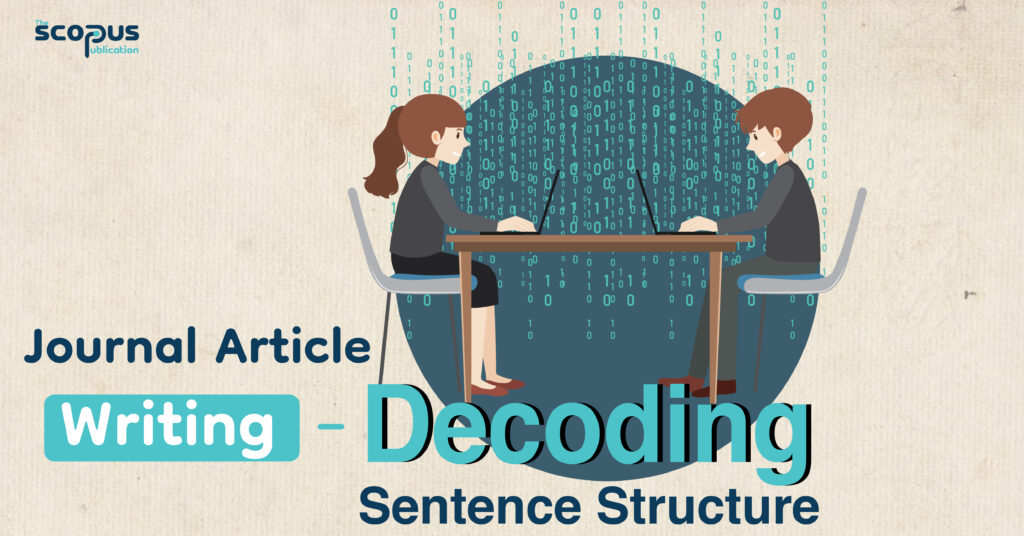Most people don’t like reading research Article only because these papers are hard to read and use technical language. These papers uncover new concepts, links, and theories and demand intense focus and attention so they can be fully comprehended. The inclusion of novel information in your paper should be the only reason behind the difficulty in comprehension of your paper, don’t over-complicate it with difficult or error-prone sentence structure.
Many researchers believe that journal article are less readable because of the inclusion of technical and subject-specific terminology, truth be told, it’s the writers who make these studies difficult with their poor writing skills. Out of these writing skills, sentence structure lapses are most disheartening for readers who want easy-to-follow phrases and sentences.
This blog post will define the proper sentence structure for English sentences together with the mistakes being committed by many researchers.
Typical Sentence Structures
Simple sentences are the most commonly used sentence structure in English language. This structure is the first to master for writing skills and researchers must rely on it the most during the writing process to keep their writing smooth and flowing. These sentences start with a noun or pronoun acting as the subject. This subject is followed by the predicate which defines the action or adjective of the subject.
Other sentences are built using the same formula but only with more information thrown into the mix. Here are three other most commonly used sentence structures in English:
Compound Sentences
Unlike simple sentences, compound sentences give more than one piece of information about the noun. Sometimes, they relate to more than one subject. These two or more pieces of information are connected by conjunctions.
Complex Sentences
This sentence structure connects two pieces of information out of which one is independent and the other is dependent.
Compound-Complex Sentences
These sentences mix up the attributes of the compound as well as complex sentences. These sentences give two or more pieces of information using more than independent clauses and at least one dependent clause.
In every sentence listed above, we will see one or more subjects followed by a similar number of predicates.
Common Sentence Structure Mistakes
Here are a few common mistakes that may arise when researchers write their article for research paper publication:
Omission of Verb
Every predicate must contain one or more verbs. The English language renders every sentence that doesn’t include a verb incorrect. It happens in one of the two ways:
First, you can commit this omission when you forget to type of write the verb.
Incorrect: He a letter.
Correct: He wrote a letter.
Secondly, when you use the primary verb, but leave out the auxiliary verb where it was needed.
Incorrect: He writing a letter.
Correct: He is writing a letter.
Incorrect Punctuations
You use punctuation where you want your readers to pause because a new concept will be introduced after this point. If you miss these punctuations, your readers will not know where the previous piece of information ended and should they consider the next phrase as part of the previous phrase or not.
Incorrect: If you don’t want to confuse your readers, give them simple sentences that are easy to follow and comprehensible don’t complicate their reading journey.
Correct: If you don’t want to confuse your readers, give them simple sentences that are easy to follow and comprehensible; don’t complicate their reading journey.
Long Sentences
Complex, compound, and complex-compound sentences are meant to be long. They impart a group of connected information. Sometimes, these sentences are inevitable. However, you need to be wary of their excessive use. Use these sentences only when the information nature requires them.
Also, while using these sentences, make sure to keep the number of information fragments provided in a sentence remain small. Try to cover no more than three connected concepts in one sentence, lest you lose the attention of your readers.
Pay Attention to Modifiers
Modifiers or adjectives should remain close to the nouns they are modifying or defining. After writing your article, read your sentence aloud to detect possible incorrect placement of the adjectives you used in it. Judging the right placement will come naturally to you if you are a native English speaker. If English isn’t your first language, consider getting research paper publication services complete with English editing services to ensure your sentence is conveying the intended meaning only.
The location of modifiers can change the entire meaning of the sentence. For example, see how a change in the position of the modifier ‘only’ changes the meaning of the sentence below:
I only like dancing at a party.
I like dancing only at a party.
Subject-Verb Disagreement
This disagreement between subject and verb often only acts as a grammatical mistake that causes minor discomfort for the readers. On the other hand, these mistakes can ruin the meaning of a whole sentence in some cases especially when the predicate can relate to more than one subject.
Incorrect: He asked the respondents about the impact of their childhood immigration on his career growth.
Correct: He asked the respondents about the impact of their childhood immigration on their career growth.
In the above example, although some pronouns have made it clear that the researcher was talking about the career growth of the respondents, still presence of singular, third-person pronouns may require the reader to re-read the sentence a few times to comprehend it completely.
How to Get Rid of Sentence Structure Mistakes?
Now you know the most common types of mistakes regarding sentence structures researchers use in their research papers, you can be wary of their presence in your study. Don’t worry. It’s human to make errors, but you need to acknowledge your mistakes to correct them.
Self-editing is the first step you can take to get rid of these mistakes. After that, hire professional English editing services to ensure that your article manuscript is free of all grammatical and sentence structure errors.
Take Away
This blog post talks about different sentence structures and common mistakes we commit in their regard. You can improve the readability of your draft by ensuring that you use simple to moderately complicated sentences. Giving away too much information in a single sentence is never a good idea.
If you want to work on improving your choice and use of sentence structures, you should read English literature more and take notes. To improve a single draft, try self-editing the article and hiring English editing services before sending it for research paper publication.


